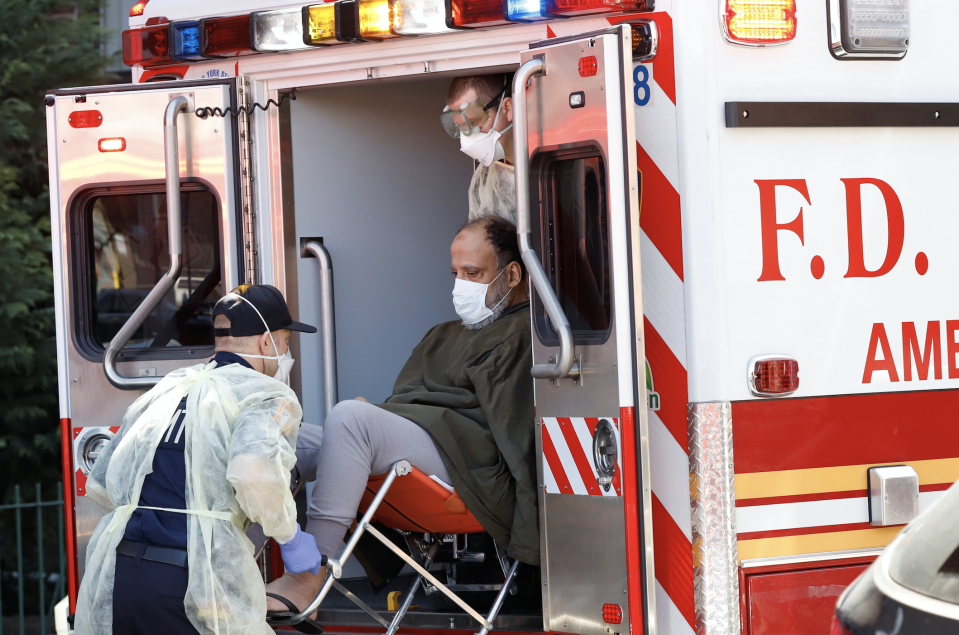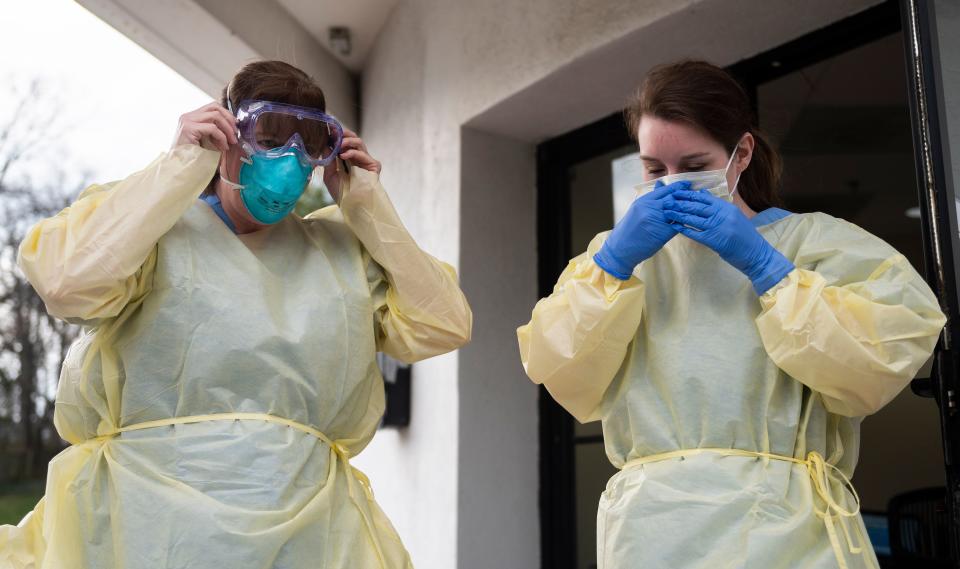Coronavirus hospital bills: A look at the costs for Americans
This post has been updated.
The coronavirus could rack up serious medical bills for Americans.
The U.S. is now the global leader in the number of coronavirus cases, and accounts for nearly 20% of all COVID-19 cases, worldwide, at over 100,000.
A report from the Kaiser Family Foundation estimated that the total cost of coronavirus treatment in a hospital could top $20,000 when factoring in out-of-pocket costs and insurance coverage.
The research factored in the average total cost of treatment for an inpatient admission for pneumonia (pneumonia is among the most serious coronavirus complications) among large employer plans in 2018. For those who suffered major complications, the cost was $20,292. For less than major complications, it cost $13,767 and for those with no complications, the cost was $9,763.
Major health providers recently announced that they would be waiving the cost of testing for those enrolled in any of their plans. But many providers also stated that any treatment would be subject to the same cost-sharing as any other medical condition depending on the plan.
On March 25, Aetna became the first major insurer to waive inpatient hospital bills for members treated for coronavirus. This includes co-pays and out-of-pocket costs. Cigna and Humana soon followed on March 29, announcing they would be waiving out-of-pocket costs related to COVID-19.

UnitedHealthcare confirmed to Yahoo Money that although it would be waiving the cost of coronavirus testing, treatment would be covered in accordance with the particular health benefit plan that the individual has. BlueCross BlueShield referred to its recent press release, detailing the steps it was taking for its members.
“That’s the great thing about private health insurance — you always have to say it depends on the plan,” Karen Pollitz, a senior fellow at the Kaiser Family Foundation, told Yahoo Money. “So you have to hit the deductible and then you can get at least some coverage for it. But there still may be a copay or there still may be 20% insurance. The plan will pay 80% and you pay 20% up to some out-of-pocket limit.”
Danni Askini, an uninsured woman treated for coronavirus in a Boston-area hospital, was slammed with a $34,927.43 hospital bill between testing and treatment.
“I was pretty sticker-shocked,” she told TIME. “I personally don’t know anybody who has that kind of money.”

‘These bills can be very expensive for people’
An additional thing to keep in mind for those with health insurance during the pandemic is to watch out for surprise medical bills.
“Essentially, it’s two situations,” Matthew Rae, associate director of the Healthcare Marketplace Project at the Kaiser Family Foundation, told Yahoo Money. “One is to go to in-network hospitals. You did your research, you found a hospital which is in your provider network, and then you end up seeing a provider who’s not part of your network.”
If the hospital you go to is in your provider network, there could still be providers within the hospital who are not, such as a radiologist or pathologist. They can charge you what’s known as balance billing — this is when a provider bills you for the difference between their charge and the allowed amount.
“When you get a balance bill, it’s typically a much higher cost,” Rae said. “And these bills can be very expensive for people and importantly, these are financial protections that are baked into your insurance plan. So out-of-pocket maximums don’t apply to spending.”

‘A real problem in this particular crisis’
Medicaid could provide a crucial role in health care coverage for treating coronavirus.
“The first thing that hopefully will get done is that if someone is uninsured and receiving treatment, the hospital or medical professionals working with them should help them investigate whether or not they are eligible for Medicaid coverage,” Linda Blumberg, an institute fellow at the Urban Institute, told Yahoo Money. “Because there are quite a number of people out there who are eligible for Medicaid but not enrolled and the best situation for these folks would be to get enrolled in Medicaid and have their costs covered through that program.”
Danni Askini, the uninsured woman hit with the $34,000+ medical bill for her coronavirus testing and treatment, told TIME that she applied for Medicaid and is hoping it will be retroactively applied to her bills.
The Affordable Care Act made it so that low-income individuals with incomes at or below the 138% level of poverty would be eligible for Medicaid. But, a June 2012 ruling by the Supreme Court made this expansion optional, so there are still 14 states that have not expanded their Medicaid programs.

For those states, Blumberg said, “that is a real problem in this particular crisis, because there are a lot of people who are going to be losing their insurance coverage and losing income all at the same time, and are going to be in need of some potentially significant amounts of medical care.”
Sara Collins, vice president at the Commonwealth Fund, told Yahoo Money that this is an opportunity for the Trump administration to follow the lead of prior administrations to expand Medicaid eligibility for those who are uninsured and diagnosed with coronavirus.
“President Bush did this during Hurricane Katrina, to allow states to temporarily cover evacuees from other states in their Medicaid programs, with the federal government paying the cost,” Collins said. “Medicaid has enormous flexibility with regard to public health emergencies like this. Using it now would help both people who become ill and the hospitals that will need to care for them.”

What to do if you’ve lost insurance because of coronavirus
Millions of people are at risk of losing their jobs because of the coronavirus and as a result, are also at risk of losing their health care coverage. There are steps to take, though, in order to find a replacement, according to Blumberg.
“These folks should definitely look into both whether they have become eligible for Medicaid because of losing their income … and check out whether or not they may be eligible for a special enrollment period for marketplace-based coverage,” Blumberg said. “If they lose their employer-based coverage, they should immediately check to see if they’re eligible. … That’s a really important thing to be aware of.”
A special enrollment period allows people to buy health coverage outside of employment. Provisions allow certain people to enroll when there have been major life events, such losing your job and therefore losing insurance. The period lasts for 60 days. The Trump administration is reportedly considering creating one due to the coronavirus, and several states have already done it for their own residents.

And, some people could even become eligible for Medicaid just for losing part of their income, such as hours being cut because of coronavirus restrictions.
“I would hope that at least the states, as well as the federal government, would put the word out about checking potential eligibility for special enrollment period, at least for people who will still have income about the poverty level,” Blumberg said.
“The subsidies in the marketplaces are only available for people between 100 and 400% of the federal poverty level. So if you’re poor and you’re in a non-expansion state and you don’t fit the narrow criteria they have for Medicaid eligibility in that particular state, these people who lose their coverage are really going to be out of luck, and it’s a serious problem.”
Adriana is a reporter and editor for Yahoo Finance. She can be reached at adriana@yahoofinance.com. Follow her on Twitter @adrianambells.
READ MORE:
1 in 3 U.S. families are skipping medical care due to cost, survey finds
Democrats and Republicans are divided on coronavirus, polls say
Former Obama official on coronavirus: 'Both the president and Congress are utterly failing'
Read the latest financial and business news from Yahoo Finance
Follow Yahoo Finance on Twitter, Facebook, Instagram, Flipboard, SmartNews, LinkedIn, YouTube, and reddit.

 money
money 
